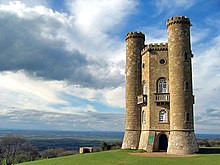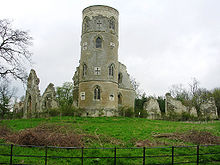Folly
This article needs additional citations for verification. (May 2010) |


In architecture, a folly is a building constructed primarily for decoration, but either suggesting by its appearance some other purpose, or merely so extravagant that it transcends the normal range of garden ornaments or other class of building to which it belongs. In the original use of the word, these buildings had no other use, but from the 19th to 20th centuries the term was also applied to highly decorative buildings which had secondary practical functions such as housing, sheltering or business use.[dubious – discuss]
18th century English gardens and French landscape gardening often featured Roman temples, which symbolized classical virtues or ideals. Other 18th century garden follies represented Chinese temples, Egyptian pyramids, ruined abbeys, or Tatar tents, to represent different continents or historical eras. Sometimes they represented rustic villages, mills and cottages, to symbolize rural virtues.[1] Many follies, particularly during famine, such as the Irish potato famine, were built as a form of poor relief, to provide employment for peasants and unemployed artisans.
Characteristics
General properties
The concept of the folly is somewhat ambiguous, but they generally have the following properties:
- They are buildings, or parts of buildings. Thus they are distinguished from other garden ornaments such as sculpture.
- They have no purpose other than as an ornament. Often they have some of the appearance of a building constructed for a particular purpose, but this appearance is a sham.
- They are purpose-built. Follies are deliberately built as ornaments.
- They are often eccentric in design or construction. This is not strictly necessary; however, it is common for these structures to call attention to themselves through unusual details or form.
- There is often an element of fakery in their construction. The canonical example of this is the sham ruin: a folly which pretends to be the remains of an old building but which was in fact constructed in that state.
What follies are not

Follies fall within the general realm of fanciful and impractical architecture, and whether a particular structure is a folly is sometimes a matter of opinion. However, there are several types which are related but which can be distinguished from follies.
- Fantasy and novelty buildings are essentially the converse of follies. Follies often look like real, usable buildings, but never are; novelty buildings are usable, but have fantastic shapes. The many American shops and water towers in the shapes of commonplace items, for example, are not properly follies.
- Eccentric structures may resemble follies, but the mere presence of eccentricity is not proof that a building is a folly. Many mansions and castles are quite eccentric, but being purpose-built to be used as residences, they are not properly follies.
- Some structures are popularly referred to as "follies" because they failed to fulfill their intended use. Their design and construction may be foolish, but in the architectural sense, they are not follies.
- Visionary art structures frequently blur the line between artwork and folly, if only because it is rather often hard to tell what intent the artist had. The word "folly" carries the connotation that there is something frivolous about the builder's intent. Some works (such as the massive complex by Ferdinand Cheval) are considered as follies because they are in the form of useful buildings, but are plainly constructions of extreme and intentional impracticality.
- Amusement parks, fairgrounds, and expositions often have fantastical buildings and structures. Some of these are follies, and some are not; the distinction, again, comes in their usage. Shops, restaurants, and other amusements are often housed in strikingly odd and eccentric structures, but these are not follies.
History
Follies began as decorative accents on the great estates of the late 16th century and early 17th century but they flourished especially in the two centuries which followed. Many estates had ruins of monastic houses and (in Italy) Roman villas; others, lacking such buildings, constructed their own sham versions of these romantic structures.
In English, such structures came to be called follies: " a popular name for any costly structure considered to have shown folly in the builder" according to one authority,[2] and were often named after the individual who commissioned or designed the project. The connotations of silliness or madness in this definition is in accord with the general meaning of the French word "folie"; however, another older meaning of this word is "delight" or "favourite abode" [3]
Another possible etymology is derived from the French cognates "feullée" or "folié", "leafy" in English. The word is marked on old Irish Ordinance Survey maps, sometimes in places where the existence of a folly building is impossible or unlikely, and some of these cases may represent areas that were wooded at the time of the survey.
However, very few follies are completely without a practical purpose. Apart from their decorative aspect, many originally had a use which was lost later, such as hunting towers. Follies are misunderstood structures, according to The Folly Fellowship, a charity that exists to celebrate the history and splendour of these often neglected buildings.[citation needed]
Follies in 18th Century French and English Gardens

Follies (FR: fabriques) were an important feature of the English garden and French landscape garden in the 18th century, such as Stowe and Stourhead in England and Ermenonville and the gardens of Versailles in France. They were usually in the form of Roman temples, ruined Gothic abbeys, or Egyptian pyramids. Painshill Park in Surrey contained almost a full set, with a large Gothic tower and various other Gothic buildings, a Roman temple, a hermit's retreat with resident hermit, a Turkish tent, a shell-encrusted water grotto, among other features. In France they sometimes took the form of romantic farmhouses, mills and cottages, as in Marie Antoinette's Hameau de la Reine at Versailles. Sometimes they were copied from landscape paintings by painters such as Claude Lorrain and Hubert Robert. Often they had symbolic importance, illustrating the virtues of ancient Rome, or the virtues of country life. The temple of philosophy at Ermenonville, left unfinished, symbolized that knowledge would never be complete, while the temple of modern virtues at Stowe was deliberately ruined, to show the decay of contemporary morals.
Later in the 18th century, the follies became more exotic, representing other parts of the world- they included Chinese pagodas, Japanese bridges, and Tatar tents.[4]
Famine Follies
The Irish Potato Famine of 1845-49 led to the building of several follies. The society of the day held that reward without labour was misguided. However, to hire the needy for work on useful projects would deprive existing workers of their jobs. Thus, construction projects termed "famine follies" came to be built. These include: roads in the middle of nowhere, between two seemingly random points; screen and estate walls; piers in the middle of bogs; etc.[5]
Examples
Follies are found worldwide, but they are particularly abundant in Great Britain. See also Category:Folly buildings.

France
- Chanteloup Pagoda, near Amboise
- Désert de Retz, folly garden in Chambourcy near Paris, France (18th century)
- Parc de la Villette in Paris has a number of modern follies by architect Bernard Tschumi.
- Ferdinand Cheval in Châteauneuf-de-Galaure, built what he called an Ideal Palace, seen as an example of naive architecture.
- Hameau de la reine, in the park of the Château de Versailles
Hungary
- Bory Castle at Székesfehérvár
- Taródi Castle at Sopron
- Vajdahunyad vára in the City Park of Budapest
India

Ireland
- Carden's Folly
- Casino at Marino
- Conolly's Folly
- Larchill in County Kildare, with several follies
- St Anne's Park, which contains a number of follies
- The Wonderful Barn
Italy
- The Bomarzo Gardens
Russia
- Ruined towers in Peterhof, Tsarskoe Selo, Gatchina, and Tsaritsino
- Creaking Pagoda and Chinese Village in Tsarskoe Selo
- Dutch Admiralty in Tsarskoe Selo
Ukraine

- Swallow's Nest near Yalta
United Kingdom



- Ashton Memorial, Lancaster, England
- Beckford's Tower, Somerset, England
- Broadway Tower, The Cotswolds, England
- Bettisons Folly, Hornsea, England
- Black Castle Public House, Bristol, England
- The Cage at Lyme Park, Cheshire, England
- The Castle at Roundhay Park, Leeds, England
- Clavell Tower, Dorset, England
- Clytha Castle Monmouthshire
- The Caldwell Tower, Lugton, Renfrewshire, Scotland.
- Dunmore Pineapple, Falkirk, Scotland
- Faringdon Folly, Faringdon, Oxfordshire
- Flounder's Folly, Shropshire, England
- The Folly Tower at Pontypool, Wales
- Fonthill Abbey, Wiltshire, England
- Fort Belvedere, Surrey, England
- Freston Tower, near Ipswich, Suffolk
- Gothic Tower at Goldney Hall, Bristol
- The Great Pagoda at the Royal Botanic Gardens, Kew, London¨
- Gwrych Castle, one of Europe's largest follies, Abergele, North Wales
- Hadlow Tower, Hadlow, Kent, England
- Hawkstone Park, follies and gardens in Shropshire, England
- Hume Castle. Berwickshire, Scotland
- Horton Tower, Dorset, England
- King Alfred's Tower, Stourhead, Wiltshire, England
- Mow Cop Castle, Cheshire, England
- National Monument, Edinburgh, Scotland
- Old John, Bradgate Park, Leicestershire, England
- Penshaw Monument, Penshaw, Sunderland, England
- Perrott's Folly, Birmingham, England
- Pope's Grotto, Twickenham, south west London, England.
- Portmeirion, Wales
- The Ruined Arch at the Royal Botanic Gardens, Kew, London
- Rushton Triangular Lodge, Northamptonshire (16th century)
- Severndroog Castle, Shooter's Hill, south-east London
- Sham Castle, Bathwick Hill, Bath, Somerset[1]
- Two of the follies in Staunton Country Park have survived until the present day
- Stowe School has several follies in the grounds
- Sway Tower, New Forest, England
- Tattingstone Wonder, near Ipswich, Suffolk
- The Temple near Castle Semple Loch, Renfrewshire, Scotland.
- Wainhouse tower, the tallest folly in the world, Halifax, England
- Wentworth Follies, Wentworth, South Yorkshire
- Williamson's tunnels, probably the largest underground folly in the world, Liverpool, England
- Wilder's Folly, Sulham, Berkshire, England
- McCaig's Tower, Oban, Argyle and Bute, Scotland.
United States
- Bancroft Tower, Worcester, Massachusetts
- Belvedere Castle, New York City
- Bishop Castle, outside of Pueblo, Colorado
- Cabazon Dinosaurs, Cabazon, California
- Italian Barge, Villa Vizcaya, Miami, Florida
- Körner's Folly, Kernersville, North Carolina
- Lawson Tower, Scituate, Massachusetts
- Lucy the Elephant, Margate City, New Jersey
Australia
- Ballandean Pyramid Ballandean, Queensland
- Big Bridge at the entrance to Peter Warren Cars at Warwick Farm, New South Wales
- Big Banana, Coff's Harbour New South Wales
- The Golden Guitar Tamworth, New South Wales
See also
References
- ^ Yves-Marie Allain, Janine Christiany, L'art des jardins en Europe, Citadelles & Mazenod, Paris, 2006.
- ^ Oxford English Dictionary, 2nd ed., 1989, vol VI, p4.
- ^ " ... and many French houses are still named "La Folie"" - OED.
- ^ Yves-Marie Allain and Janine Christiany, L'art des jardins en Europe, Citadelles & Mazenod, Paris, 2006.
- ^ Howley, James. 1993. The Follies and Garden Buildings of Ireland. New Haven: Yale University Press. ISBN 0-300-05577-3
Bibliography
- Barlow, Nick et al. Follies of Europe, Garden Art Press, 2009, ISBN 978-1870673563
- Barton, Stuart Monumental Follies Lyle Publications, 1972
- Folly Fellowship, The Follies Magazine, published quarterly
- Folly Fellowship, The Follies Journal, published annually
- Folly Fellowship, The Foll-e, an electronic bulletin published monthly and available free to all
- Hatt, E. M. Follies National Benzole, London 1963
- Headley, Gwyn Architectural Follies in America, John Wiley & Sons, New York 1996
- Headley, Gwyn & Meulenkamp, Wim, Follies — A Guide to Rogue Architecture, Jonathan Cape, London 1990
- Headley, Gwyn & Meulenkamp, Wim, Follies — A National Trust Guide, Jonathan Cape, London 1986
- Headley, Gwyn & Meulenkamp, Wim, Follies Grottoes & Garden Buildings, Aurum Press, London 1999
- Howley, James The Follies and Garden Buildings of Ireland Yale University Press, New Haven & London, 1993
- Jackson, Hazelle Shellhouses and Grottoes, Shire Books, England, 2001
- Jones, Barbara Follies & Grottoes Constable, London 1953 & 1974
- Meulenkamp, Wim Follies — Bizarre Bouwwerken in Nederland en België, Arbeiderpers, Amsterdam, 1995
